External Links:
Overview
Many people have a dream of visiting Polynesia, the island world of the South Seas.
The Maori have lived forever on these islands, which they settled about 3000 years ago along with New Zealand.
Join us on this adventure to the South Seas.
Find new islands with discoverer ships and create your own island world with palms, shells and leis.
Start with the basic game and then add the variations, which offer additional options and fun.
Contents
- 5 playerboards (2-sided)
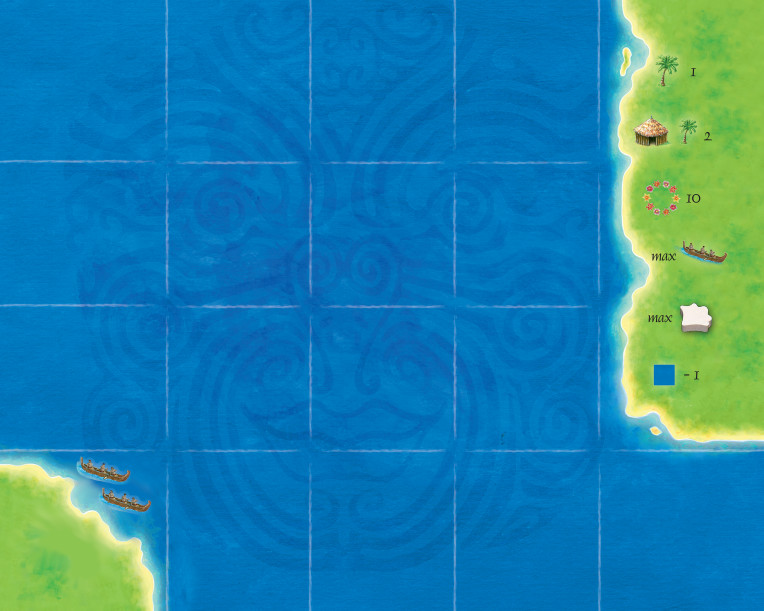

- 97 island tiles in the following forms
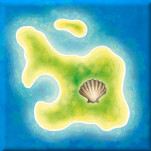
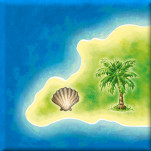
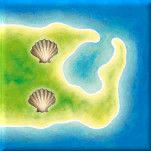
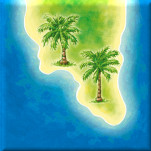
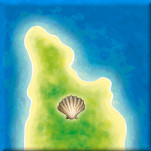
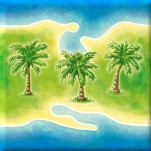
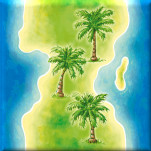




10 individual islands, 54 end pieces, 14 middle pieces, 17 water tiles, 2 volcanoes
Additionally, the island tiles show other symbols: palms, huts, shells, ships and leis.
Note: as there are no curve tiles, only straight islands can be discovered.
- 30
 shells
shells
- 1
 discoverer ship
discoverer ship
Preparation
Shuffle the island wafers (in the remaining rules: tiles) face-down.
Draw 16 tiles and lay them face-up in a 4 x 4 matrix as show below.
If a volcano tile is drawn, set it aside and draw another tile to use instead.
After the matrix is complete, shuffle any drawn volcano tiles into the group of face-down tiles.
Stack the remaining face-down tiles in supply stacks nearby.
Each player takes a player board, which he places in his play area.
In addition, each player takes 5 shells as starting capital.
Place the remaining shells nearby as a supply.
The players choose a starting player randomly.
The starting player places the discoverer ship at the edge of the matrix next to the tile of his choice.
Goal
Each player has his own board, on which he tries to create a valuable island world.
To do so, he collects tiles from the matrix in the center, which is explored by the discoverer ship.
In this way, each player develops islands with palms, huts, and leis, which earn the player points.
The game ends when a player fills his board.
Playing the game
The game is played in clockwise order.
The player to the left of the player, who placed the discoverer ship, begins.
On a player’s turn does the following in the order shown:
- He must move the discoverer ship.
- He may discover a tile.
Then, the next player in clockwise order takes his turn.
1. Move the discoverer ship
The player first must move the discoverer ship around the matrix in the clockwise direction.
He must move the discoverer ship at least 1 step and at most as many steps as he has ships on his board.
At the beginning, each player has 2 ships (printed on the board).
During the game, a player can get additional ships.
In addition, a player can spend shells to move the discoverer ship even further: 1 shell = 1 step.
Examples for the movement of the discoverer ship:
- The player has 2 ships and can move the discoverer ship up to 2 steps.
- The player has 2 ships and moves the discoverer ship 2 steps,
then pays 1 shell to move another step.
2. Discover a tile
After the player moves the discoverer ship, the player must do one of the following:
- Take 1 tile from the matrix and place it on his board.
- Take 1 tile from the matrix and place it in his storage.
- Take 1 tile from his storage and place it on his board.
- Discard 1 tile from his board.
- Do nothing.
Take one tile from the matrix and place it on his board.
This is the normal action and the most frequently executed.
He takes the edge tile next to the ship free of charge, or takes another tile from the row or column.
For each tile skipped, he pays 1 of his shells to the supply.
 |
 |
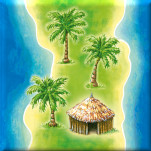 |
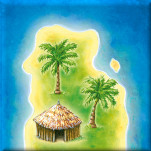 |
 |
|
0 Shells |

1 Shells |


2 Shells |



3 Shells |
The player can take the tile next to the discoverer ship free of charge.
The second tile costs 1 shell,
the third tile costs 2 shells, and
the fourth tile costs 3 shells.
The player puts the tile he took on any empty water space on his board.
Players must place palms so that appear face-up to the player placing them.
When a player puts a tile with shells on his board,
he takes that number of wooden shells and places them on his storage, if such are still in the supply.
Take one tile from the matrix and place it in his storage.
Instead of putting the tile he took on his board, the player can place it in his storage.
In a subsequent turn, the player can take it from his storage and put this tile on the board.
Important: each player has only one storage space.
Only when it is empty can he put another there.
Take one tile from his storage and place it on his board.
Instead of taking a tile from the matrix, the player can take the tile from his storage and put it on his board
(if he has a tile in his storage).
Discard one tile from his board.
A player may remove a tile from his board.
He takes any tile from his board and puts it back into the box.
As it costs a turn, a player will use this only when he needs to remove a tile from his board
that stands in the way of important development of his island world.
Do nothing.
This only makes sense if the player has no useful play.
Important notes
Regardless of which option a player selects, he must always first move the discoverer ship at the beginning of its turn.
A volcanic tile cannot be taken.
That Volcano represents a blockade.
Tiles on the other side of a volcano tile from the discoverer ship cannot be taken.
In any case, palms on a tile must appear upright to the player placing them.
After a tile is taken from the matrix, the player replaces it with a tile from the supply stacks.
When all supply stacks are exhausted, the space in the matrix remains empty.
The shells
Players must keep their shells openly in their play areas and can be used as follows:
- to pay to move the discoverer ship extra steps and
- to pay to take a tile not adjacent to the discoverer ship.
Game end
The game ends when a player fills his board completely.
However, each other player takes one more turn before the game is scored.
Scoring
Before the scoring, the players remove all incomplete islands from their boards so that those fields become empty water spaces again.
Each player now determines his score.
A player earns points for:
- Each palm on an island without a hut counts for 1 point.
- Each palm on an island with at least one hut counts for 2 points.
(An island with more than 1 hut does not earn a player more palm points.)
- Each complete lei counts for 10 points.
- The player with most ships on his player board
(including those shown on the board) scores 1 point for each ship he has.
If players tie with most, each scores points for all his ships.
- The player with most shells scores 1 point for each shell he has (ties treated as above).
The shells shown on the tiles are not counted.
- Each empty water space on the board costs 1 minus point.
- Tiles in storage are not scored.
The player with most points is winner of the game.
If player tie with the most points, the player among those tied with the most shells wins.
Scoring example
| 10 palms without hut | 10 points |
| 6 palms with hut | 12 points |
| 1 complete lei | 10 points |
| 7 boats (majority) | 7 points |
| 3 shells (no majority) | 0 points |
| 2 empty water spaces | -2 points |
| total | 37 points |
The variations
For the variation games, the small ships are needed.
At the beginning of the game, each player takes a ship in his color and places this beside his board.
To the original movement rules, a further point is added:
- The player must move the discoverer ship.
- The player may discover an island.
- The player may or must move his ship.
Variation 1 ("Advanced Rules": the player may move his ship)
When a player puts his first tile on his board, he must place his ship on this tile.
When he places tiles on his board in subsequent turns, he must place the tiles
horizontally, perpendicularly, or diagonally adjacent to the tile where his ship stands.
As in the basic, a player may place a tile in his storage (if this is not yet occupied)
or remove a tile from his board instead of placing a tile on his board.
After placing a tile, the player can move his ship to any tile on his board.
He can also leave his ship where it stands.
He may, however, never place his ship on an empty water space.
The player may also move his ship, when he puts a tile in his storage or removes a tile from his board.
Variation 2 ("Pro-Rules": the player must move his ship)
Variation 2 offers an additional requirement to variation 1.
The player must always place his ship on a tile he places on his board.
He may not move his ship, if he puts a tile into his storage, removes a tile from his board, or does nothing.
He may not remove the tile his ship stands on from his board.
Additional spending wooden shells in the variations
Before the player puts a tile from the matrix or from his storage onto his board, he may move his ship.
Each step costs a wooden shell.
The Atoll (back side of the player board)
The back side of the player boards shows an atoll in the center of the board.
The players can choose to play on the back sides for variety.
The scoring changes as follows: all islands, which are situated completely within the atolls, double their palm values.
That is, islands with huts earn 4 points for each palm; islands without huts earn 2 points per palm.
Leis are not doubled.
The space with the ship graphic within the atoll is considered an empty water space and can be covered with a tile.
If the space is not covered, it counts during scoring as 1 minus point.